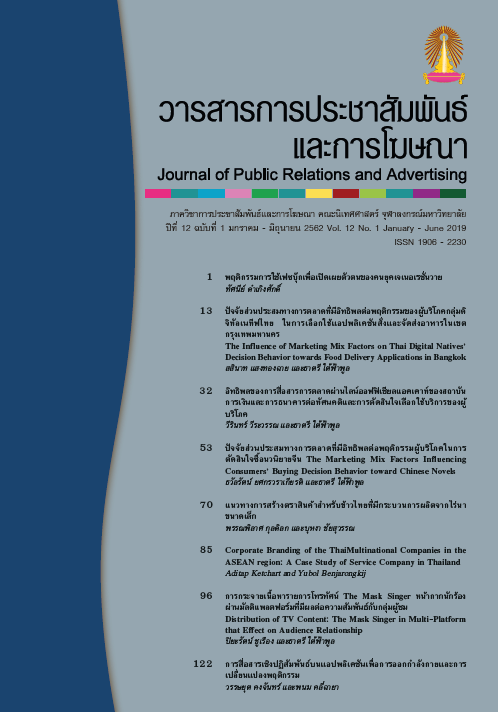The Influence of Marketing Mix Factors on Thai Digital Natives’ Decision Behavior towards Food Delivery Applications in Bangkok
Main Article Content
Abstract
The purpose of this quantitative research was to study Thai digital natives’ media and information exposure, attitudesand behavior towards food delivery applications. Questionnaires were used to gather the data from 384 digital natives’ users around Bangkok area. Food delivery services including: Foodpanda, LINE MAN, and UberEATs were represented as food delivery applications.
The study showed that Thai digital natives with difference income, experienced difference media and information exposure towards Foodpanda and LINE MAN applications. Thai digital natives with difference family members, experienced difference media and information exposure towards Foodpanda application. However, Thai digital natives with difference genders, ages, education level, occupation, status, income, and family members not experienced any difference media and information exposure towards all food delivery applications. The same consumes also not experienced any difference in attitude towards food delivery applications and the decision of using food delivery applications.
In addition, the factors that affected Thai digital natives’ decision behavior were attitude towards food delivery applications (Beta = 0.394)with statistical significance at 0.01 and media and information exposure towards food delivery applications (Beta = 0.231) with statistical significance at 0.01.
Article Details
References
Lekasina. (2559). วิถีสตาร์ทอัพ. สมุทรปราการ: เนชั่นบุ๊คส์.
“LINE MAN” หวังฐานลูกค้า 1 ล้านรายปีหน้า. (2560). Retrieved from http://www.manager.co.th/Cyberbiz/ViewNews.aspx?NewsID=9600000058350.
PwC ชี้คนไทยครองแชมป์ช้อปออนไลน์มากที่สุดในโลก ยุค “มิลเลนเนียล” ผู้นำโมบายช้อปปิ้ง. (2559). Retrieved from http://thaipublica.org/2016/pwc-18-4-2559/
เกริดา โคตรชารี. (2555). ปัจจัยนำของการรับรู้ความเสี่ยงและพฤติกรรมการซื้อสินค้าออนไลน์ของผู้บริโภคเจเนอเรชั่นเอ็กซ์และเจเนอเรชั่นวาย. (วิทยานิพนธ์ปริญญามหาบัณฑิต), จุฬาลงกรณ์มหาวิทยาลัย.
ถึงมาใหม่แต่พี่ใหญ่สุด LINE MAN ฉลอง 1 ปี ด้วยตำแหน่งเบอร์ 1 Food Delivery. (2560). Retrieved from https://www.brandbuffet.in.th/2017/06/lineman-1st-year-anniversary/.
ทิวา ยอร์ค. (2556). ทำไม…ต้องขายสินค้าบนโลกออนไลน์ (E-Commerce). Retrieved from https://mgronline.com/smes/detail/9560000059748
เธียรทศ ประพฤติชอบ. (2557). เมื่อเขามาฉันจะไปจริงหรือ? (สื่อเก่า VS สื่อใหม่)213, 11-12. Retrieved from http://www.tpa.or.th/tpanews/upload/mag_content/84/ContentFile1692.pdf.
ปรมะ สตะเวทิน. (2546). การสื่อสารมวลชน กระบวนการและทฤษฎี. กรุงเทพฯ: ภาพพิมพ์.
มาดูกันชัด ๆ Foodpanda, Lineman, UberEATS ใครมีอะไรดีกว่ากัน! (2560). Retrieved from http://urbancreature.co/foodpanda-lineman-ubereats/.
ศุภรัศมิ์ ฐิติกุลเจริญ. (2554). ทฤษฎีการสื่อสาร. กรุงเทพฯ: สำนักพิมพ์มหาวิทยาลัยเกษตรศาสตร์.
ศูนย์วิจัยกสิกรไทย. (2559). จับตาปี’ 60 สั่งอาหารออนไลน์หนุนตลาด Delivery โตร้อยละ 11-15 สวนทางภาพรวมธุรกิจร้านอาหารที่เติบโตเพียงเล็กน้อย. Retrieved from https://www.kasikornresearch.com/InfoGraphic/Documents/2797_p.pdf.
สำนักงานพัฒนาธุรกรรมทางอิเล็กทรอนิกส์ (องค์การมหาชน) กระทรวงเทคโนโลยีสารสนเทศและการสื่อสาร. (2560). รายงานผลสำรวจพฤติกรรมผู้ใช้อินเทอร์เน็ตในประเทศไทยปี 2560. กรุงเทพมหานคร: สพธอ.
อัชฌา สุทันกิตระ. (2554). การรับรู้และทัศนคติต่อแหล่งข้อมูล และพฤติกรรมการแสวงหาข่าวสารและซื้อกระเป๋าแบรนด์เนมบนอินเทอร์เน็ต. (วิทยานิพนธ์ปริญญามหาบัณฑิต), จุฬาลงกรณ์มหาวิทยาลัย.
ภาษาอังกฤษ
Assael, H. (1998). Consumer behavior and marketing action (6th ed.). Cincinnati, OH: South-Western College.
Hanna, N., & Wozniak, R. (2001). Consumer behavior: An applied approach. New York: Prentice Hall.
Hernandez, B., Jimenez, J., & Martin, M. J. (2011). Age, gender and income: Do they really moderate online shopping behavior? Online Information Review, 35(1), 113-133.
Herther, N. K. (2009). Digital natives and immigrants: What brain research tells us. Online, 33(6), 15-21.
Hunt, T., & Ruben, B. D. (1993). Mass communication: Producers and consumers. New York: Harper Collins College Publishers.
Kimes, S. E. (2011). The current state of online food ordering in the US restaurant industry. Cornell Hospitality Report, 11(17), 6-18.
Klapper, J. T. (1960). The effects of mass communication. New York: Free Press.
Liang, A. R., & Lim, W. M. (2011). Exploring the online buying behavior of specialty food shoppers. International Journal of Hospitality Management,30(4) 855-865.
McCombs, M. E., & Becker, L. B. (1979). Using mass communication theory. Englewood, NJ: Prentice Hall.
Paul, J. P., & Olsen, J. C. (1994). Understand Consumer Behavior. Illinois: Irwin.
Schiffman, L. G., & Kanuk, L. L. (2010). Consumer Behavior (10th ed.). Essex: Pearson Education.
Solomon, M. R. (2015). Consumer behavior buying, having, and being (11th ed.). Essex: Pearson Education.
Tapscott, D. (2009). Grown up digital: How the net generation is changing your world. New York: McGraw-Hill.


